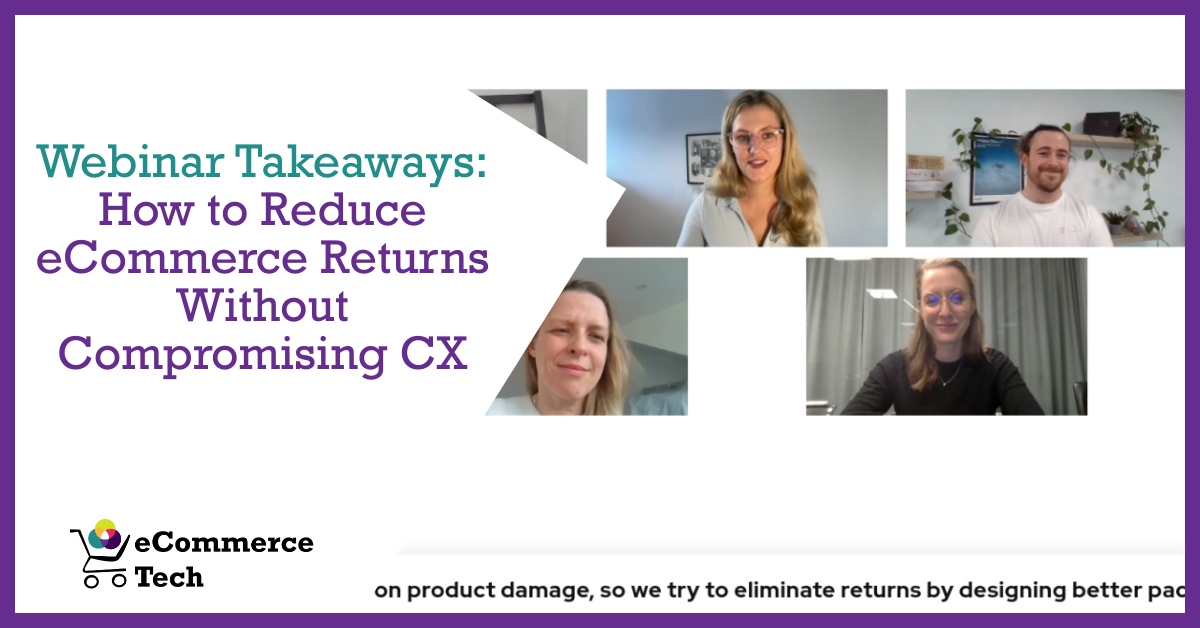Returns aren’t just a footnote in your checkout flow. They reflect how well your business truly serves your customers and how well your systems talk to each other. You're not just behind if you’re still considering returns as a logistics problem. You’re bleeding money, loyalty, and time.
And the numbers? They sting. In 2023, US retailers processed over $743 billion in returns, 14.5% of total retail sales. That’s nearly a trillion dollars worth of uncertainty, dissatisfaction, and sometimes bad sizing. But here’s the kicker: returns aren't the enemy. Mishandling them is.
Returns are not the end of a transaction. They’re the start of a deeper relationship. That’s what makes them so frustratingly underrated. They touch everything: your product descriptions, your warehouse, your customer service tone, and your tech stack. When done right, they unlock loyalty, trust, and profit.
That’s exactly what came through in the latest eCommerce Explored session hosted by Chloe Thomas. She gathered four experts who live and breathe post-purchase: packaging strategy, returns portals, and sustainability. Here’s what we learnt.
Meet the Experts
- Amber Forbes – Senior Client Success Manager at 5874 Commerce. With a sustainability-focused thesis and five years in ecommerce, Amber knows how to make data sing.
- Josh Pitman – Managing Director at Priory Direct, a certified B Corp. For Josh, packaging isn’t just about protection; it’s a conversation with your customer.
- Sophie Aubard – CEO at Yayloh. Based in Sweden, Sophie is all about transforming messy return processes into customer-friendly, insight-rich systems.
- Sarah McVittie – Co-founder of Dressipi. She’s helping fashion brands show customers only what they’ll keep, cutting returns through better choices upfront.

When No One Owns Returns, Everyone Pays
You know that sinking feeling when a problem sits right before everyone, yet no one takes it personally? That’s how many ecommerce businesses treat returns. Sarah called it out: “The operation isn’t the place that’s really going to reduce the quantity of returns. You need buy-in from systems, and you need the data on what products are coming back so you can make changes at the front end.”
Returns are often dumped on ops. However, the root cause could be a vague product description, a missed Instagram expectation, or a size chart disconnect. When returns are nobody’s KPI, they quietly pile up. Sophie didn’t hold back: “Not having anyone in the company truly owning [returns] is a challenge.”
If no one’s driving the feedback loop from returns to insight to action, you’re not reducing them. You’re just recycling them.

Every Return Tells a Truth, Are You Listening?
I’ve seen this too many times: teams collect return data, throw it in a spreadsheet, and call it a day. But data isn’t just for your records; it’s for your roadmap. Amber gets it: “If a customer is making a return, always find the reasons why and capture as much data as you can… make sure that you act on that data.”
Returns are signals. Why did they happen? Is it the product? The copy? The photos? Josh says this is where businesses fall apart: “It cuts to the core a lack of coordination around data.”
And Sarah dropped the sharpest warning: “Be very careful that what [customers] are saying in the forms is actually true.”
Form data isn’t gospel. Cross-check it with order history, customer profiles, and known SKU issues. Only then can you turn returns pain into strategic clarity.
Your Packaging Is Talking, What’s It Saying?

What sets the tone before a return is even initiated? Packaging. Josh sees the link: “At the point of receipt of goods is a good place to manage customer expectation.”
When customers are confused by what’s in the box or how to send it back, you’ve already lost a piece of their trust. Smarter businesses are now baking returns into packaging design.
Josh explained: “Dual-journey packaging with two peels and seals will speed up your operation, speed up the processing of your returns, and minimise the amount of wasted space and huge balls of packing tape.”
It’s not just prettier parcels. It’s operational clarity and customer confidence in one.
Go Digital—Paper Slips Are Killing Your Data
We live in a world where customers tap to track pizza in real time. And yet, some retailers still ask them to handwrite return reasons on paper. Sophie said what we were all thinking: “Ask your customer to fill in a written form on paper (they will not feel engaged, and then it can be complicated for you to collect the data).”
This isn’t just a UX issue; it’s a missed data opportunity. Digital returns portals aren’t just convenient. They make your entire post-purchase journey measurable. Sophie spelled it out: “A digital returns portal is the starting point.”
A portal gives structure. It guides the user. It collects consistent data. It also shows you care enough to make the experience intuitive.
The Best Way to Reduce Returns? Predict What They’ll Keep
Let’s flip the conversation: What if customers only saw products they’re likely to love?
That’s what Sarah’s team at Dressipi is building. She explained:
“Your heaviest returners are also your heaviest customers. You know that their best size is X. You can predict their size, and don’t show them things that are not available in their size.”
Data isn’t just about fixing problems after the fact. It’s about reducing friction before checkout. And on the design side:
“Women with a large bust will return high necks. So don’t show those women those sorts of products; put things in front of them that they will love and keep.”
That’s not magic; it’s clarity.
Customers Don’t Want to Return, Help Them Avoid It
There’s this myth that customers love abusing free returns. But Sophie cracked that open:
“95% of your clients hate to return products. They just want to buy the products which they’re going to keep.”
Returns aren’t about gaming the system. They’re usually a failure of communication or presentation. So fix those, and customers will gladly keep what they buy. But when they do return, don’t punish them.
Instead, design it to win them back: “Make returns smoother and easier for the client because, in the long term, it will actually benefit the brand [and] build long-term loyalty.”
To Wrap Up
Returns don’t have to be a loss. They can be your biggest feedback loop, sustainability unlock, and secret to smarter selling. Let’s stop dreading them and start designing around them.
Returns done well = retention done right.
This was just a slice of the full conversation. If you want to dig into the full panel, including what happens when you charge for returns, how carbon costs factor into logistics, and what not to do when streamlining ops, watch the full webinar on our YouTube channel. Also, you can sign up for our eCommerce Explored series and get early access to upcoming sessions, replays, and speaker recaps.





